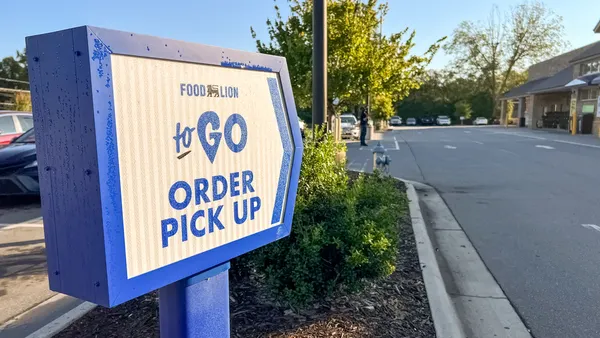Dive Brief:
- Walmart's first-quarter showed the unprecedented impact of the COVID-19 crisis on the retail giant's business, with U.S. comparable sales jumping 10%, according to a press release. With its e-commerce sales exploding, growing by 74% in Q1, Walmart announced that it would discontinue its Jet.com unit. In doing so, the company said Jet was "critical to accelerating our omni strategy."
- As Walmart's sales increased, so did its costs as Walmart took measures to make stores safer from the spread of the novel coronavirus, and compensate employees for their risk. The retailer paid $755 million in special cash bonuses to all hourly associates and accelerated payment of $170 million in a regular bonus program.
- It hired more than 235,000 new associates during the quarter as it tried to meet "unprecedented" demand. It added nearly $11 billion in revenue to its quarterly sales, posting $134.6 billion for Q1, an 8.6% year-over-year increase to its top line.
Dive Insight:
The coronavirus crisis has driven shoppers to use grocery e-commerce in order to avoid stores, which resulted in Walmart's decline in store foot traffic for April. Shoppers are instead using store pickup and delivery, which reached all-time high volumes this quarter. The number of new customers trying pickup and delivery has increased four times since mid-March. According to Walmart, many of those customers are beginning to make repeat purchases.
In response the retailer has expanded its grocery pickup and delivery slots and added more general merchandise items to complement grocery purchases. As of Q1, the retailer has nearly 3,300 store pickup locations and more than 1,850 stores with same-day grocery delivery. Its Express Delivery launched at nearly 1,000 stores and will increase to 2,000 by the end of June.
Despite the reduction of in-store shoppers, Walmart saw the overall basket size increase, with average ticket sales in Q1 up 16.4%. The retailer also officially nixed Jet.com, once a centerpiece of the company's e-commerce strategy.
In a conference call, CEO Doug McMillon said that the Jet brand name may still be used in the future, but recently the Walmart brand, through its walmart.com offer, had dominated the company's resources and people devoted to e-commerce because of the traction it has with consumers.
McMillon couched the decision to kill Jet.com in a broader discussion about ways Walmart was looking to cut costs and find efficiencies as it boosted spending to manage pandemic shopping. It is perhaps the logical endpoint of a series of tactical moves in Walmart's online strategy.
Last year, the company nixed Jet's independent executive, sweeping it into its broader e-commerce offering. It also stopped selling fresh groceries to the New York City area one year after it launched. The retailer sold off ModCloth, one of the brands meant to attract consumers specifically to Jet, and axed its Jet Black shop-by-text service tailored to rich urbanites. And data from Gartner L2 provided to Retail Dive last fall show Walmart's steep drop in marketing spending on Jet and a resulting plummet in the website's sales, while walmart.com's took off.
By and large, Walmart's quarter was dominated by the pandemic. CFO Brett Biggs said Q1 brought "the broadest set of challenges we've ever seen globally," with a complex and quickly shifting regulatory landscape, as well as fast-changing consumer habits.
That brought both higher sales — including new customers signing up through pick up and delivery channels— and smaller margins for Walmart.
"The reductions in margins, especially when considering at least $900 million in coronavirus-oriented spend and the explosion in higher-cost online sales, is actually fairly benign, indicating that Walmart's online business was able to largely handle this growth surge within its existing capability," Charlie O'Shea, lead Walmart analyst for Moody's, said in emailed comments.
GlobalData Retail Managing Director Neil Saunders said in emailed comments that his firm's data showed the COVID-19 crisis brought many new customers to Walmart. "Some of these were unable to get what they wanted elsewhere, some were attracted to Walmart because of its wide ranges which enabled them to stock-up, and some were driven by the lower-prices which helped them save money," he said.
On the e-commerce front, Saunders noted Walmart was able to ramp up its capacity in a way others weren't in Q1, and that digital was helped along by Walmart's omnichannel services like store pick up. "That Walmart has outperformed Amazon, at least in growth terms, underlines both the deficiencies of Amazon in grocery — which generated the bulk of sales this quarter — and Walmart's growing power in the segment," Saunders added.















